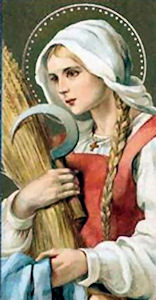 The St. Zita Society by Ruth Rendell
The St. Zita Society by Ruth RendellIn this, her sixty-second book, Ruth Rendell channels ethologist Jane Goodall. The population under study, however, isn't lowland gorillas, but the residents of Hexam Place, a swanky street of white-painted stucco or golden brick Georgian houses in Knightsbridge, London.
 Living in these houses is a diverse group in class, character, and ethnicity. Lord and Lady Studley, their two servants, and their driver, Henry Copley, reside at the large, detached Number 11. Gay men Damian Philemon and Roland Albert, Thea, who teaches information technology classes, and 92-year-old Miss Grieves all have flats in Number 8. Rabia Siddiqui, a widowed Muslim woman who's wonderfully warm and honest, is the nanny for Preston and Lucy Still's youngest child at Number 7. Monserrat Tresser, 23-year-old daughter of one of Preston's friends, is their live-in au pair. Her Serene Highness the Princess Susan Hapsburg has lived at Number 6 with her lady's maid, June Caldwell, since the Princess left her husband, an iffy Italian prince, 60 years earlier. The Princess's cleaner was born in Antigua and also cleans several other Hexam Place homes. The Kleins, a pair of Americans, celebrate Thanksgiving at Number 14. At Number 3 is an easy-going pediatrician, Dr. Simon Jefferson, and his handsome driver Jimmy, who has a bedroom downstairs. Dr. Jefferson's gardener, Dex Flitch, also tends Ivor Neville-Smith's garden at Number 5.
Living in these houses is a diverse group in class, character, and ethnicity. Lord and Lady Studley, their two servants, and their driver, Henry Copley, reside at the large, detached Number 11. Gay men Damian Philemon and Roland Albert, Thea, who teaches information technology classes, and 92-year-old Miss Grieves all have flats in Number 8. Rabia Siddiqui, a widowed Muslim woman who's wonderfully warm and honest, is the nanny for Preston and Lucy Still's youngest child at Number 7. Monserrat Tresser, 23-year-old daughter of one of Preston's friends, is their live-in au pair. Her Serene Highness the Princess Susan Hapsburg has lived at Number 6 with her lady's maid, June Caldwell, since the Princess left her husband, an iffy Italian prince, 60 years earlier. The Princess's cleaner was born in Antigua and also cleans several other Hexam Place homes. The Kleins, a pair of Americans, celebrate Thanksgiving at Number 14. At Number 3 is an easy-going pediatrician, Dr. Simon Jefferson, and his handsome driver Jimmy, who has a bedroom downstairs. Dr. Jefferson's gardener, Dex Flitch, also tends Ivor Neville-Smith's garden at Number 5.Of all the characters we meet, Dex shows us most openly that The St. Zita Society is a Rendell creation. Dex is a former patient of Dr. Jefferson's friend Dr. Mettage. After trying to kill his mother, Dex has been declared sane. He has seen no evil spirits since coming to work for the kindly Dr. Jefferson in Hexam Place, but sometimes it takes weeks of observing and following them before Dex can be sure. To Dex, people appear as if they wear featureless masks. His smiles scare Jimmy. He never told Dr. Mettage or Dr. Jefferson that women feel like a threat to him, although he did tell Peach, his god. Peach resides in his cell phone and communicates with Dex in enigmatic ways. Then again, what are a god's ways––stopping the rain, making the sun shine, getting Dex a job––if not mysterious?
Like the rest of England, Hexam Place is not a classless society, but the upper and lower classes intertwine, as well as interact in the roles of employer and employee. Monserrat, a not-so-nice woman, doesn't do much for anyone unless it's to her advantage; socialite Lucy Still makes use of this trait when she wants to see her lover. Preston Still, a wealthy insurance baron, loves his children, but expresses it only in his concern for their health. Seemingly more than both of them put together, Rabia loves their baby, Thomas. Dr. Jefferson came from a working-class family and wouldn't hear of Jimmy, his driver, calling him "sir" and would walk half a mile without complaint to where the car is parked. Jimmy, rather than despising Dr. Jefferson for this, rather likes him. On the other hand, Lord Studley thinks nothing of making Henry wait in the car outside Number 11 for two hours. And this is the reason some of the Hexam Place household help meet at the neighborhood pub, the Dugong, to form the St. Zita Society.
 |
| St. Zita |
Hexam Place is united, more or less, by the tradition of candles in the windows at Christmas time. The neighbors share the visits of an urban fox that slinks from house to house, but prefers the garbage of Miss Grieves. Miss Grieves can't get up the stairs fast enough to chase the fox, but she keeps a gimlet eye out for it and on her fellow citizens. The fox can be excused for its manners; after all, it is a wild animal. What about Hexam Place's human residents? How does one account for their immoral behavior and their deliciously unexpected deaths?
 |
| photo by Jerry Bauer |
Note: It's easy to learn the characters' names and their relationships if you photocopy the street map, which shows the houses and their occupants, on the inside cover of the book.



Georgette, Dex with his Peach sounds wonderfully creepy, like someone who wandered in from a Minette Walters book. Hagiography is endlessly surprising and St. Zita is a new one to me. Photocopying that street map might be the only way to keep track of that many characters, but it sounds like a good book to curl up with on crisp fall evenings.
ReplyDeletePeri, yes, like Minette Walters and Margaret Millar, Rendell is a master at depicting damaged people trying to fit in. When you meet Dex, you think, "Uh oh"; however, it's not always the obviously ticking time bombs who detonate and make a mess.
ReplyDeleteThe photocopied street map came in very handy for me, and with it, it doesn't take long to grasp who's who.
I love Ruth Rendell. While keeping violence and gore to a minimum, she shows us how people's character and behavior precipitate crime and what happens in the aftermath. This particular book reminds me a bit of Muriel Spark's A FAR CRY FROM KENSINGTON in its concentration on the psychology of individuals and what happens when individuals are thrown together.
It seems that the kindle edition of this book does not include the street map. Is it important enough that one should buy a physical copy of the book?
ReplyDeleteSheryl
Sheryl, I purchase few books these days because I have two kids in college. The map is helpful, but not mandatory. I'd get the hardcover from the library. If that isn't possible, don't worry about it. At the beginning, it will be a little bit confusing, but if you're patient, it won't take long before everyone's personalities and relationships are straight in your head.
ReplyDeleteThanks
ReplyDeleteSheryl